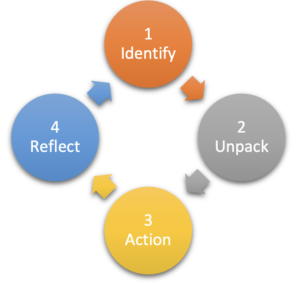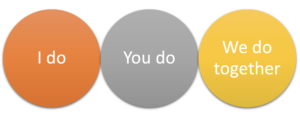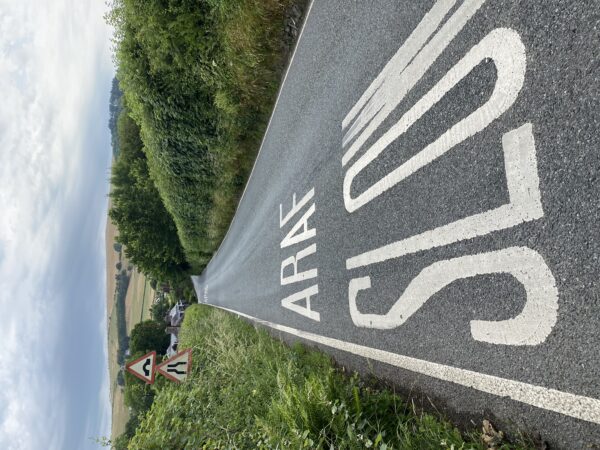In this blog post, I invite you to join me on a journey as I reflect on my role as an EdTech and pedagogical coach. Through continuous learning and years of experience, I’ve carefully crafted my own coaching model. This journey has been shaped by attending a number of coaching courses, building connections within the edTech coaching community, extensive research into various approaches, and accumulating years of hands-on coaching experience.
 My coaching model is essentially a four-stage cyclical process:
My coaching model is essentially a four-stage cyclical process:
Stage 1: Identify
The coaching cycle often begins with a trigger, such as:
- For students, it could be disappointing results in an exam.
- For teachers, it might be the realization that classroom management has become challenging, with numerous behaviour-related issues.
For me, successful coaching hinges on the recognition that assistance is required and there is a genuine desire for improvement. During this phase of the coaching cycle, the primary aim is to establish a desired outcome, which can initially be quite broad in scope.
Stage 2: Unpack
During this stage, my primary objective is to delve deeper into the perceived problem and uncover the underlying issues. Examples of my approach include:
- For Students: Analysing the outcomes of an exam, scrutinizing how questions were marked. In the case of an IB DP paper, it may mean drilling down to the type of command terms employed. Were the learner’s strengths primarily in AO1, AO2, or AO3 responses? Is there a specific content area that needs attention?
- For Teachers: It’s about encouraging the teacher to share the circumstances surrounding the issue. I aim to elicit detailed narratives—asking questions like “Tell me more about what happens and when?” This step allows teachers to articulate their experiences and stories.
Active listening is a cornerstone of this stage, where I listen intently and engage in visible thinking techniques. These techniques might involve drawing diagrams and jotting down ideas on paper, creating tangible reference points for our discussions. By the end of this stage, the learner may have revised or restated their desired goal based on these deeper insights.
Stage 3: Action
I then transition into the action planning phase. Here, I encourage the learner to delve deeper, to ideate and consider various actions required to address the identified issues and achieve the desired goal.
In this stage, we work together to formulate an action plan, or at least lay the foundation for it. While we outline the next steps in detail, it’s important to maintain flexibility and agility. We don’t want to become overly locked into a fixed course of action, as circumstances can evolve. Key considerations include when, where, and how these actions will take place.
Stage 4: Reflect
After an agreed period of action, we meet to reflect and share the student or teachers progress toward their goal. I encourage them to consider what’s working effectively and what might need adjustments.
The beauty of this coaching cycle is its continuity and we returning to Step 1. It’s important to recognise that achieving meaningful growth and change often requires multiple cycles of reflection, analysis, and action. Each iteration bringing the learner closer to the desired outcome, promoting continuous improvement and growth.
Key Reminders
Here are some essential tips and insights that I often remind myself of:
- The 70/30 Rule: In every coaching session, whether formal or informal, my aim is to follow the 70/30 rule. This means I dedicate 70% of the time to actively listening and asking questions, allowing the teacher or student to speak and process their thoughts.
- Coaches as Teachers – Finding the Balance: Coaching involves believing that learners possess their own answers. However, part of the solution may involve upskilling, which the pedagogical or EdTech coach can assist with. This shift from coach to instructor and back is pivotal in the coaching cycle.
- Exploration Leads to Discovery: Sometimes, in my role as an eLearning coordinator and EdTech coach, I find it beneficial to demonstrate certain features of software packages or digital solutions used in classrooms. This helps uncover teachers’ needs and tailor solutions accordingly. After all, you don’t know what you don’t know.
- Shiny New Tools: When teachers express a desire to use a new tool, even when faced with limitations like a restricted internet, coaching conversations about the “what,” “why,” and “how” of using the tool can lead to more suitable and effective solutions.
-
 Gradual Release of Responsibility: When helping teachers upskill in EdTech solutions and pedagogical practices, I follow the Gradual Release of Responsibility model (Fisher and Frey) breaking down instruction into three stages: demonstration (I do), collaborative practice (we do together), and independent practice (learner tries with me as a guide on the side).
Gradual Release of Responsibility: When helping teachers upskill in EdTech solutions and pedagogical practices, I follow the Gradual Release of Responsibility model (Fisher and Frey) breaking down instruction into three stages: demonstration (I do), collaborative practice (we do together), and independent practice (learner tries with me as a guide on the side).
In conclusion, to me, it’s paramount to keep in mind that coaching is an ever-evolving and adaptable process, finely tuned to meet the unique needs and goals of each individual. This dynamic approach to coaching holds the potential for not only the positive growth of the learners but also for my own development as a coach.
For further research, I highly recommend Cognitive Coaching a course developed by Arthur Costa and Robert Garmston, which is an approach to professional coaching that focuses on cognitive processes and helps individuals, typically educators, enhance their thinking and problem-solving skills.
Photo Credit: Author. Welsh road markings

Be First to Comment